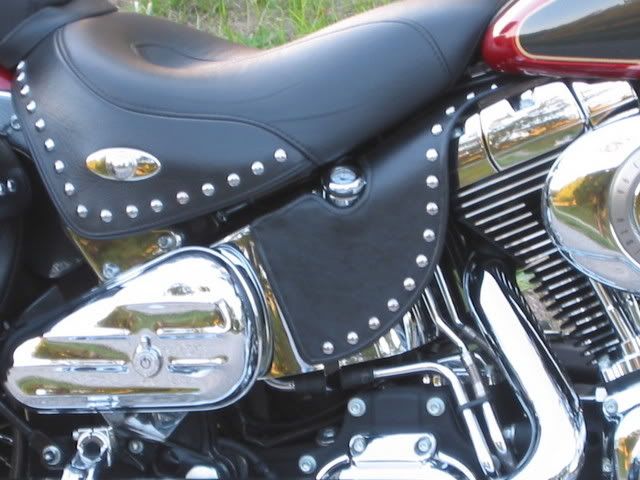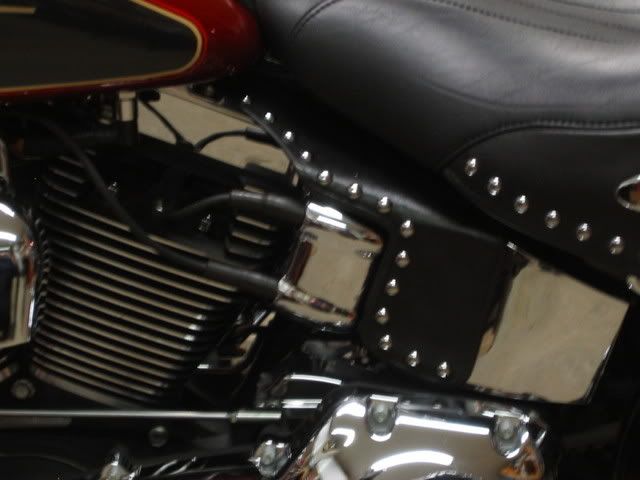You are using an out of date browser. It may not display this or other websites correctly.
You should upgrade or use an alternative browser.
You should upgrade or use an alternative browser.
Heat Shields
- Thread starter RetNavyHD
- Start date
flh canuck
Active Member
I need heat shields that will direct more heat at the rider.
Brrrrrr. Could somebody please pass the hot chocolate.....:newsmile062:
Brrrrrr. Could somebody please pass the hot chocolate.....:newsmile062:
+1 on the No More Fired Thighs by RJ Originals. Wife and I rode 8 hrs in 105 temps and while it was hot, not nearly as bad as without. The go on easy, come of easy, and are made in the USA.
burdes, thank you for promoting my product!
RJ
Hey RetNavy,
I second Glider's comment about the RJS Originals. I purchased a set for my Heritage back in late 2007 and they not only direct the heat away from me and the wife's legs, but they also look good on the bike. The quality is great and Zoood will take calls on install issues - great guy to deal with!
Here's what they look like on my Heritage.


waterdog, thanks for posting the pictures. Now I have some nice close-ups of your install on a 07 heritage for my site. Glad to see n hear that you like the product.
RJ
Sharky1948
Junior Member
Sorry if this is redundant...didn't read the whole thread. But...
An alternative (or addtion) to heat shields is having the headers ceramic coated. My '09FLHR had an exhaust temp (stock) of 1200F before ceramic coating. After the coating the temp was 800F. About $450, but worth it in my opinion.
An alternative (or addtion) to heat shields is having the headers ceramic coated. My '09FLHR had an exhaust temp (stock) of 1200F before ceramic coating. After the coating the temp was 800F. About $450, but worth it in my opinion.
Sorry if this is redundant...didn't read the whole thread. But...
An alternative (or addtion) to heat shields is having the headers ceramic coated. My '09FLHR had an exhaust temp (stock) of 1200F before ceramic coating. After the coating the temp was 800F. About $450, but worth it in my opinion.
I guess every little bit helps.
But took the initiative and looked the following up:
LISTSERV 15.5 - SAFETY Archives
These U.S. Army data might provide guidance:
HOT SURFACE SKIN CONTACT
MOST PROBABLE SKIN TEMPERATURE EFFECT or SENSATION
212o F second-degree burn with 15- (boiling water)
second contact
180o F second-degree burn with 30- second contact
160o F second-degree burn with 60- second contact
140o F pain; tissue damage (burns)
120o F pain; "burning heat"
LapLogic
When Does Hot Become Dangerous?
Being hot is, at best, simply uncomfortable. Laptop heat can actually raise your body temperature, much as a heating pad would, forcing your body to adapt by forcing blood to the surface of the skin to cool it, resulting in "flushing" or "blushing". It also forces your body to produce sweat at a higher rate which, in meeting rooms or rooms with low air flow, can make you simply miserable.
However, there comes a point where hot stops being uncomfortable and become dangerous. The medical profession breaks burns into three classes - first, second and third degree burns.
First degree burns are similar to a bad sunburn - the outer layer of the skin is damaged superficially and, while painful, it is not exceptionally dangerous unless it covers a large area of the body. There is no blistering.
Second degree burns go through the skin layers. Blisters are present. In some cases, skin grafts are required for the injury to heal. There is a high risk of infection and scarring. Second degree burns are extremely painful and require special medical treatment.
A third degree burn is extremely serious. It destroys the skin and often causes extensive scarring. Third degree burns are actually painless as all of the nerves have been killed. Third degree burns can also destroy muscle tissue and bones, leading to crippling injuries.
Serious burns can happen very quickly, depending on the temperature of the item coming in contact with the skin:
Temperature °F Second DegreeBurns¹ Third DegreeBurns¹
113 °F 1.7 hours 2.8 hours
122 °F 2 minutes 8 minutes
131 °F 11 seconds 20 seconds
140 °F 2 seconds 5 seconds
Even tho the above findings are from contact with hot surfaces. It still provides an idea of what our human tolerances are to heat.
So even at 800 degrees. The heat reduction you paid for doesn't alleviate
what one feels from the heat that radiates off the back head while setting there at a traffic light. Even tho you coated your exhaust pipes. The pipes transfer the heat, but the main culprit or source is that rear cylinder head.
I did extensive research when I designed my heat deflectors. I dont care what type of heat deflector anyone chooses. I'm just stating that what ever you choose to place between your inner thighs and the heat source will make a difference.
RJ
Sharky1948
Junior Member
RJ,
I'm not knocking the product at all.
But, I don't think that a reduction of 33% of the exhaust heat going by the pillion's legs (and my thighs) should be classified as "little bit." And, I'm not suggesting that 800F is a temp that folks cuddle up to. Finally, I understand that the rear cylinder contibutes a lot of heat. But, everyone with an '09 touring bike has experienced the significant heat reduction related to Harley re-routing the pipes. Reducing pipe temp is a significant part of the equation.
JMHO
I'm not knocking the product at all.
But, I don't think that a reduction of 33% of the exhaust heat going by the pillion's legs (and my thighs) should be classified as "little bit." And, I'm not suggesting that 800F is a temp that folks cuddle up to. Finally, I understand that the rear cylinder contibutes a lot of heat. But, everyone with an '09 touring bike has experienced the significant heat reduction related to Harley re-routing the pipes. Reducing pipe temp is a significant part of the equation.
JMHO
I guess every little bit helps.
But took the initiative and looked the following up:
LISTSERV 15.5 - SAFETY Archives
These U.S. Army data might provide guidance:
HOT SURFACE SKIN CONTACT
MOST PROBABLE SKIN TEMPERATURE EFFECT or SENSATION
212o F second-degree burn with 15- (boiling water)
second contact
180o F second-degree burn with 30- second contact
160o F second-degree burn with 60- second contact
140o F pain; tissue damage (burns)
120o F pain; "burning heat"
LapLogic
When Does Hot Become Dangerous?
Being hot is, at best, simply uncomfortable. Laptop heat can actually raise your body temperature, much as a heating pad would, forcing your body to adapt by forcing blood to the surface of the skin to cool it, resulting in "flushing" or "blushing". It also forces your body to produce sweat at a higher rate which, in meeting rooms or rooms with low air flow, can make you simply miserable.
However, there comes a point where hot stops being uncomfortable and become dangerous. The medical profession breaks burns into three classes - first, second and third degree burns.
First degree burns are similar to a bad sunburn - the outer layer of the skin is damaged superficially and, while painful, it is not exceptionally dangerous unless it covers a large area of the body. There is no blistering.
Second degree burns go through the skin layers. Blisters are present. In some cases, skin grafts are required for the injury to heal. There is a high risk of infection and scarring. Second degree burns are extremely painful and require special medical treatment.
A third degree burn is extremely serious. It destroys the skin and often causes extensive scarring. Third degree burns are actually painless as all of the nerves have been killed. Third degree burns can also destroy muscle tissue and bones, leading to crippling injuries.
Serious burns can happen very quickly, depending on the temperature of the item coming in contact with the skin:
Temperature °F Second DegreeBurns¹ Third DegreeBurns¹
113 °F 1.7 hours 2.8 hours
122 °F 2 minutes 8 minutes
131 °F 11 seconds 20 seconds
140 °F 2 seconds 5 seconds
Even tho the above findings are from contact with hot surfaces. It still provides an idea of what our human tolerances are to heat.
So even at 800 degrees. The heat reduction you paid for doesn't alleviate
what one feels from the heat that radiates off the back head while setting there at a traffic light. Even tho you coated your exhaust pipes. The pipes transfer the heat, but the main culprit or source is that rear cylinder head.
I did extensive research when I designed my heat deflectors. I dont care what type of heat deflector anyone chooses. I'm just stating that what ever you choose to place between your inner thighs and the heat source will make a difference.
RJ
RJ,
I'm not knocking the product at all.
But, I don't think that a reduction of 33% of the exhaust heat going by the pillion's legs (and my thighs) should be classified as "little bit." And, I'm not suggesting that 800F is a temp that folks cuddle up to. Finally, I understand that the rear cylinder contibutes a lot of heat. But, everyone with an '09 touring bike has experienced the significant heat reduction related to Harley re-routing the pipes. Reducing pipe temp is a significant part of the equation.
JMHO
I know your NOT knocking the product. I was just stating that it doesnt take much heat to make one uncomfortable.
RJ
Last edited:
I found a new laser cut boot guard at the Denver Swap Meet 09. This keeps my foot off the pipes and my passenger's off the left pipe behind the primary. They installed in a couple of minutes and I did not have to drill them into the floorboard. The company was bitchin-guard, I think. I looked on their web page, but the new touring models for the floorboards were not posted yet. They had told me that they were brand new. They were selling a lot of them. I got the laser cut wings, but I liked the POW/MIA ones too. I'm sure you can email them and they can show you pics.